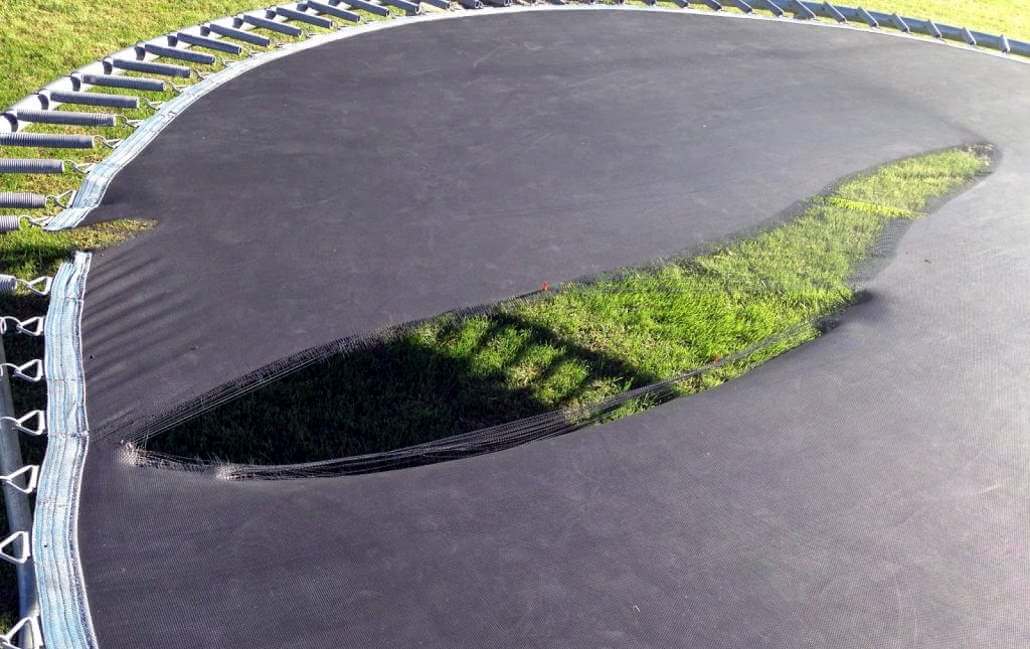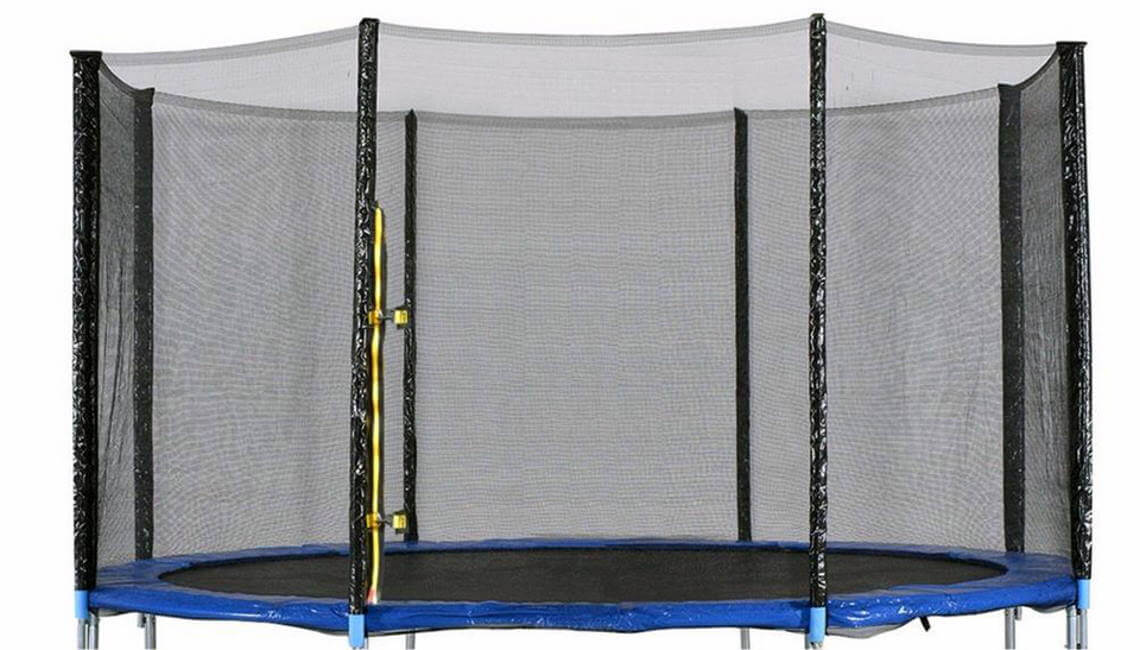Are Modern Trampolines Safe?
When we bounce with our kids, we want them to be safe first and foremost. You’d think that trampolines and safety don’t go hand in hand, but you’d be wrong. It certainly held true back in the heyday, when safety standards were lax and trampolines looked like deathtraps. It’s not like that today, fortunately.
Safety and Age
We enjoy our kids having fun, but don’t want it to come at a huge cost. Over time, we heard many parents say their kids loved trampolines so much and were begging them to buy one that they simply had to cave in.
That’s fine, but doing some research beforehand is in order. Not all trampolines are equally safe, and truth be told, trampolines are riskier than some other forms of entertainment. The risk isn’t huge, but it’s there and you should always keep an eye on your kids while they’re bouncing away.

Younger children should never jump unsupervised or use larger trampolines (over 10 ft). Luckily, special kids trampolines exist tailor-made for them that keep them safe. The bounce isn’t high and they’re all covered in foam. Older children (usually 6 and up) can use backyard trampolines, but only one at a time.
Never let more than one kid jump at the same time. That’s how most accidents occur!
One more thing we can recommend is to check reviews of kids trampolines, prior to buying one. You can check all children trampolines or our Selection of best-buy kids trampolines!
Risks involved with trampolines
Trampolines are safe for recreational use if proper adult supervision is present, and adherence to strict safety rules is maintained – this is the opinion of most trampoline manufacturers and supporters. The American Academy of Pediatrics (AAP) and other organizations such as the Consumer Product Safety Commission (CPSC) don’t think so…
According to them, trampolines, if not maintained properly, can provide big safety risk for anyone using it, especially children while playing some trampoline games on backyard trampoline.
When did all started? 
Rapid increase in trampoline sales during 1990’s, which is considered a decade when trampolines started to gain popularity, all without detailed safety standards to comply to, has lead to epidemic of trampoline related injuries, with total of eleven deaths.
All that lead to fact that several organizations, among them American Organization of Pediatrics, were struggling to completely ban sale of home trampolines.
However, this call to action didn’t result in banning trampolines but did resolve in improvement of safety standards for trampolines, and in 2003. new safety standards for trampoline enclosures.
Key Trampoline Safety Guidelines
Let’s face it: Trampolines can look intimidating, especially when it’s your own kids who want to jump on them. However, over time I found that it’s of no use denying them this simple pleasure. Plus – it’s healthy for them!
At first, I’d let my kids jump at their neighbors’ place, but they managed to cajole me into buying them a trampoline they can use on their own. And believe me, was is scared out of my mind! Here I was, a responsible mom of two, buying my kids what seemed like a deathtrap!
Luckily everything turned out well. Today’s trampolines are MUCH safer than they used to be and nobody I know had any accidents on their trampolines. That’s not to say accidents can’t happen. I believe they do happen, but if you follow the safety guidelines carefully, you’ll have no issues. Here’s what I feel is the key to a safe and fun experience!
One at a time
Official stats and manufacturers themselves advise against letting multiple jumpers on the trampoline at the same time. Their advice is solid. When two people jump, they can accippingidentally hit or land on each other. Ow! The bouncing motion itself can make it harder to predict how and where you want to bounce – so you risk completely losing control. It’s bad enough for an adult, let alone a kid!
You can imagine how difficult it was for me to convince my children that it’s unsafe to bounce around together, but I was firm on this rule and they quickly accepted that. There are plenty of trampolines in the market that provide interaction for the child away from the trampoline – some come with cool tablet games (tgoma), others have nifty basketball hoops and similar. There is also a variety of trampoline games around that you can teach your kids. Or sometimes they’ll just come off the trampoline to catch a breath. Bouncing is exhausting!
Mind the age limit
It’s always a good idea to trust the manufacturer’s age range. If the minimum says 12 years, then it’s 12 even if doesn’t look like that to you. Maybe you’re missing something – say the bounce is too high for younger kids. It’s something you can’t notice before you buy and can prove dangerous. Always buy from reputable manufacturers that take care to mention the minimum age.
My children are a bit older, but if they were younger I’d look into a dedicated kids’ trampoline. They make them smaller and less bouncy (but still fun!). They can be stored indoors and are even cheaper than regular ones, and also come with loads of foam. It’s a good option for kids aged 4-8.
No tricks
Unless your kids are gymnasts, they shouldn’t be doing flips or somersaults. My friends’ kid would do such feats I would cringe when I saw her do that, fully expecting her to break her neck. Nothing happened (I found out she’s a gymnast) but I’d never let my kids do that. Know their limits and lay down the rules.
No somersaults, no flips, no fancy bounces. Don’t be too strict – allow them to have fun, but don’t allow them to do as they please. Mind that we have a list of fun trampoline games that even multiple children can enjoy!
Check the mat

Always check for scratches and holes in the mat. If it’s just a little hole, it becomes a safety concern. Mat’s are the ones that are stiff and absorb most of the force while jumping, so small holes can really quickly become big ones. You don’t want your kid to fall through. Inspect, inspect, inspect!!!
Click to learn more about how important mats really are.
Keep it level
A trampoline is more stable the more legs it has, but no legs can save it if you put it on an uneven surface. We used a string trick – hammer two stakes into the ground, where the sides of the trampoline would be and tie the string from one stake to another to check for surface slope.
If it isn’t level, move it or add extra soil to level it out. Most trampolines don’t come with adjustable legs so you’re out of luck here. Non-level trampolines can be insecure as they move during bouncing and are less stable in severe weather.
Supervise, supervise, supervise
Even though you might want to relax and pamper yourself while you’re alone, please don’t let your kids bounce unsupervised. Despite high-tech enclosures, trampolines can still be risky and you should take care.
But it doesn’t mean you have to stand right next to the trampoline. Just be around and watch for any shenanigans. You can make yourself a (soft) drink and recline in the backyard. Invite your kids’ friends and chat with their parents while they play.
Get an enclosure

A good trampoline enclosure is a must. It consists of sturdy, padded poles that hold taut, strong netting that goes around the entire trampoline mat. The enclosure should be high enough so that people aren’t able to jump over it, and strong enough to keep the bouncer inside even if they mistime and misjudge a jump. We prefer enclosures where the netting is sewn directly onto the mat, keeping the entire spring area outside of the enclosed bouncing surface.
You should never purchase a trampoline without enclosure. Even though an overwhelming majority of trampolines on the market come with an enclosure, there still are some that go without. Avoid them unless you’re a pro.
Safety pads always on!

It’s important to have fairly thick safety pads (at least about an inch) that cover the springs. They cushion the force of impact and prevent limbs from getting tangled with springs. Springs can carry huge loads and forces and if a person’s finger or a toe gets stuck, it’s never a pretty sight.
Luckily, it’s rare owing to safety pads that keep the danger away. Hitting them is never pleasant, but they absorb the impact force and reduce the likelihood of injury.
If you are in two minds about which trampoline to buy, head over to ProTrampolines USA homepage and check some reviews – you just might find something you fancy. Or check our “Trampoline Buying Guide“
Studies about trampoline-related injuries
Evidence from all of those combined reports suggests that the following factors can be identified as the main cause of injury:
- More than one person on a trampoline – this is the most important factor which can be associated with injury on a trampoline and the main reason of trampoline accidents. So why is that? Well, calculations show that the lightest person on trampoline is five times more likely to be injured. There can be multiple reasons for this – from a direct collision with another jumper (10% of accidents), heavier jumper falling onto lighter jumper (broken legs, hands etc), all because of “kipping” effect.
What is “kipping” effect?
Kipping is a phenomenon where you get enhanced uplift as a result of the mattress is compressed slightly before other jumper lands on the same surface, causing the mattress and springs to be moving upwards (recoiling) at the moment when other jumper lands. It causes much greater force and momentum than the jumper expected and results in unintended rotation or even backward somersault, which can result in serious injuries.
Studies on trampoline injuries
Different studies shown different numbers so here they are – Ninewells Hospital Study (47% of injuries because of multiple users), Wotton and Harris (82% of injuries), RoSPA (75% of injuries).
- No supervision whatsoever – supervision is crucial in preventing injuries. Role of supervisor is to ensure that all safety guidelines are followed.
- Trampoline not assembled properly or on inappropriate location – loose joints, problems with padding and trampoline located near other objects can lead to serious injuries. Always follow assembly manual when setting up a trampoline and always leave at least 5 feet from other objects.
- No safety enclosure – One former research (made from 1979 – 1988) has shown that 80% of trampoline injuries occur because people fall of the trampoline. In newer studies this number is much lower, where only 22%-28% is same reason for today accidents. Still, very large number of accidents which could be avoided.
- Age of jumper – child below sex years of age. Younger children will less likely have sufficient coordination skills, skills which are crucial while jumping on trampoline, from stabilizing in mid air to control landings. Younger children have 50% more chance to get a fracture which requires surgery, when compared to general population.
- Hitting pad and springs – Study conducted in USA between 2002 – 2007 shown that almost 19% of accidents was caused by hitting the springs or frame.
Study published in The Journal of Pediatrics:
- Younger children tended to have injuries to their arms and the majority of these were fractures or dislocations.
- Younger children also had a higher rate of facial injuries, most often lacerations.
- Older children most often injured their legs and these injuries tended to be bruises, sprains, strains and contusions.
- About 3 percent of the injuries were serious enough for the children to be admitted to the hospital.
- Head and neck injuries accounted for 12 percent of the injuries in younger children. In older children, the figure was 7 percent
Study by US Consumer Product Safety Commission:
The US Consumer Product Safety Commission stated that 95,000 hospital emergency room-treated injuries in 1998 were associated with trampolines. 75 were kids under the age of 15. Then in 2002, the CPSC again estimated that 60,000 trampoline-related emergency room-treated injuries were kids between the ages of 5 and 14. Since 1990, the CPSC has received six reported deaths involving the seemingly harmless trampoline. In data from 2009. there were nearly 98,000 U.S. trampoline injuries, 0.05% of which, or about 50, caused paralysis or other permanent neurological damage, according to the National Electronic Injury Surveillance System.
According to the CPSC, most of the trampoline associated injuries were sustained at private homes. The injuries and deaths were caused by:
- Colliding with another person while jumping on the trampoline.
- Landing improperly while jumping or doing stunts on the trampoline.
- Falling or jumping off the trampoline.
- Falling on the trampoline springs or frame.


